Object-Oriented Development Methods and Iterative Life Cycle Analysis
VerifiedAdded on 2022/01/04
|8
|1585
|263
Report
AI Summary
This report delves into object-oriented development methods, focusing on the significance of iterative life cycles in system analysis and design. It examines the core principles of object-oriented programming, including encapsulation and inheritance, and how these concepts contribute to modularity and system efficiency. The report analyzes the necessity of iteration, arguing that it is crucial for breaking down complex projects into manageable components, facilitating software component reuse, and improving overall productivity. The discussion highlights the advantages of iterative approaches, such as the ability to manage complexity, improve software quality, and reduce maintenance costs. The report concludes that while object-oriented methods can be conceptually understood without iteration, practical implementation benefits greatly from it, making it an essential element of successful project execution. The report also mentions the context of a system that is to be developed has both static and a dynamic part and the static context of a system is generally designed using a block diagram while the dynamic part is modelled by making use of use case diagrams.
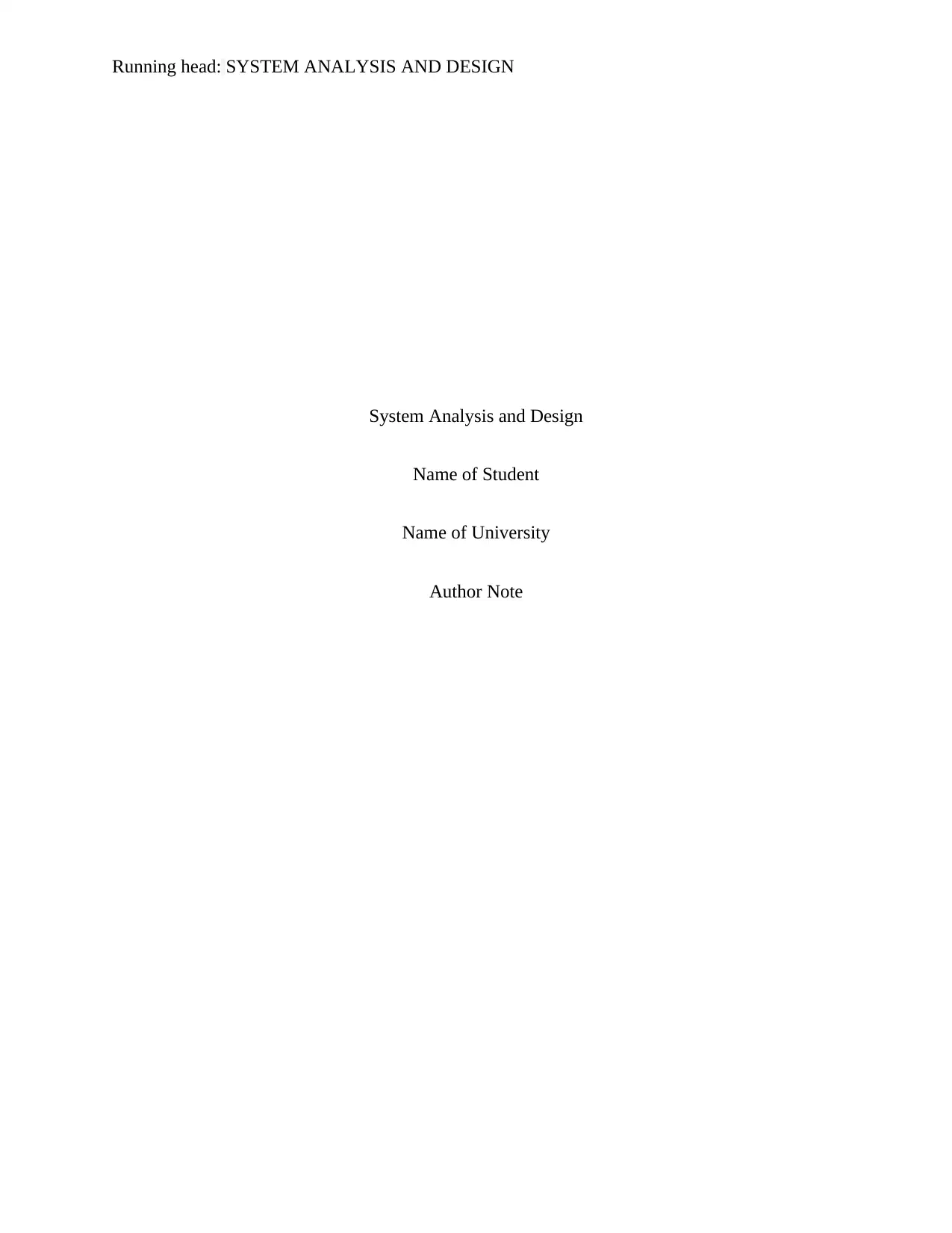
Running head: SYSTEM ANALYSIS AND DESIGN
System Analysis and Design
Name of Student
Name of University
Author Note
System Analysis and Design
Name of Student
Name of University
Author Note
Paraphrase This Document
Need a fresh take? Get an instant paraphrase of this document with our AI Paraphraser
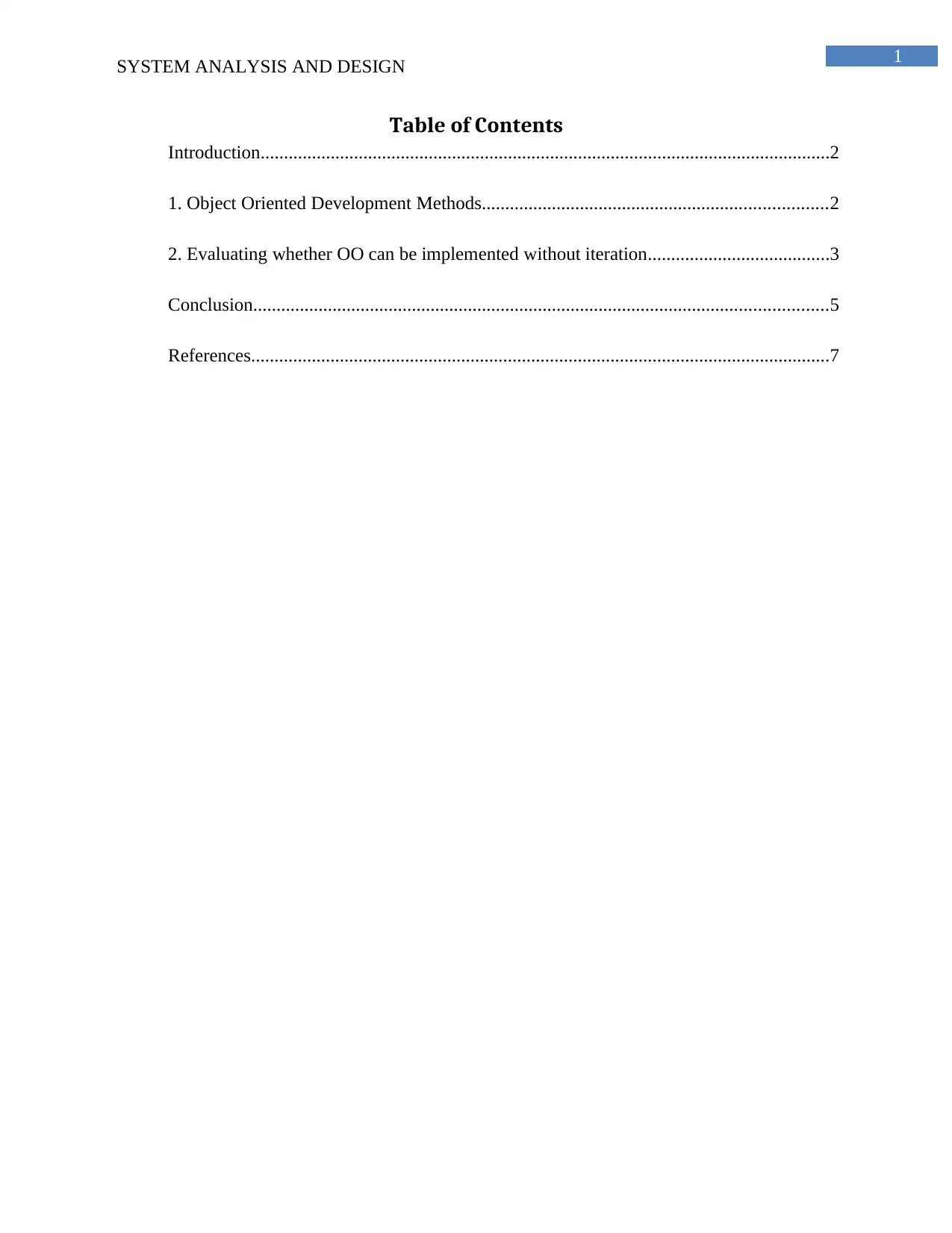
1
SYSTEM ANALYSIS AND DESIGN
Table of Contents
Introduction..........................................................................................................................2
1. Object Oriented Development Methods..........................................................................2
2. Evaluating whether OO can be implemented without iteration.......................................3
Conclusion...........................................................................................................................5
References............................................................................................................................7
SYSTEM ANALYSIS AND DESIGN
Table of Contents
Introduction..........................................................................................................................2
1. Object Oriented Development Methods..........................................................................2
2. Evaluating whether OO can be implemented without iteration.......................................3
Conclusion...........................................................................................................................5
References............................................................................................................................7
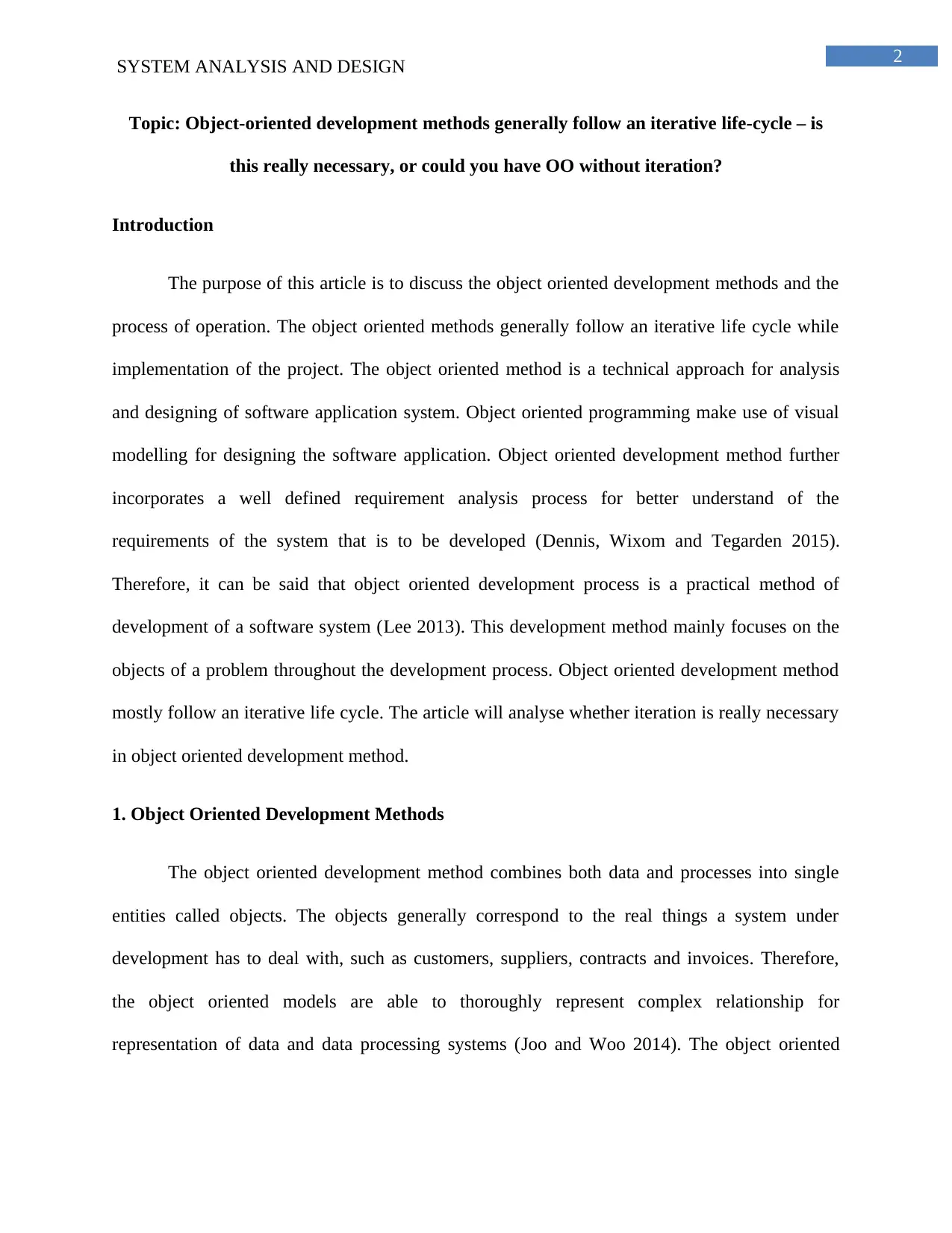
2
SYSTEM ANALYSIS AND DESIGN
Topic: Object-oriented development methods generally follow an iterative life-cycle – is
this really necessary, or could you have OO without iteration?
Introduction
The purpose of this article is to discuss the object oriented development methods and the
process of operation. The object oriented methods generally follow an iterative life cycle while
implementation of the project. The object oriented method is a technical approach for analysis
and designing of software application system. Object oriented programming make use of visual
modelling for designing the software application. Object oriented development method further
incorporates a well defined requirement analysis process for better understand of the
requirements of the system that is to be developed (Dennis, Wixom and Tegarden 2015).
Therefore, it can be said that object oriented development process is a practical method of
development of a software system (Lee 2013). This development method mainly focuses on the
objects of a problem throughout the development process. Object oriented development method
mostly follow an iterative life cycle. The article will analyse whether iteration is really necessary
in object oriented development method.
1. Object Oriented Development Methods
The object oriented development method combines both data and processes into single
entities called objects. The objects generally correspond to the real things a system under
development has to deal with, such as customers, suppliers, contracts and invoices. Therefore,
the object oriented models are able to thoroughly represent complex relationship for
representation of data and data processing systems (Joo and Woo 2014). The object oriented
SYSTEM ANALYSIS AND DESIGN
Topic: Object-oriented development methods generally follow an iterative life-cycle – is
this really necessary, or could you have OO without iteration?
Introduction
The purpose of this article is to discuss the object oriented development methods and the
process of operation. The object oriented methods generally follow an iterative life cycle while
implementation of the project. The object oriented method is a technical approach for analysis
and designing of software application system. Object oriented programming make use of visual
modelling for designing the software application. Object oriented development method further
incorporates a well defined requirement analysis process for better understand of the
requirements of the system that is to be developed (Dennis, Wixom and Tegarden 2015).
Therefore, it can be said that object oriented development process is a practical method of
development of a software system (Lee 2013). This development method mainly focuses on the
objects of a problem throughout the development process. Object oriented development method
mostly follow an iterative life cycle. The article will analyse whether iteration is really necessary
in object oriented development method.
1. Object Oriented Development Methods
The object oriented development method combines both data and processes into single
entities called objects. The objects generally correspond to the real things a system under
development has to deal with, such as customers, suppliers, contracts and invoices. Therefore,
the object oriented models are able to thoroughly represent complex relationship for
representation of data and data processing systems (Joo and Woo 2014). The object oriented
⊘ This is a preview!⊘
Do you want full access?
Subscribe today to unlock all pages.

Trusted by 1+ million students worldwide
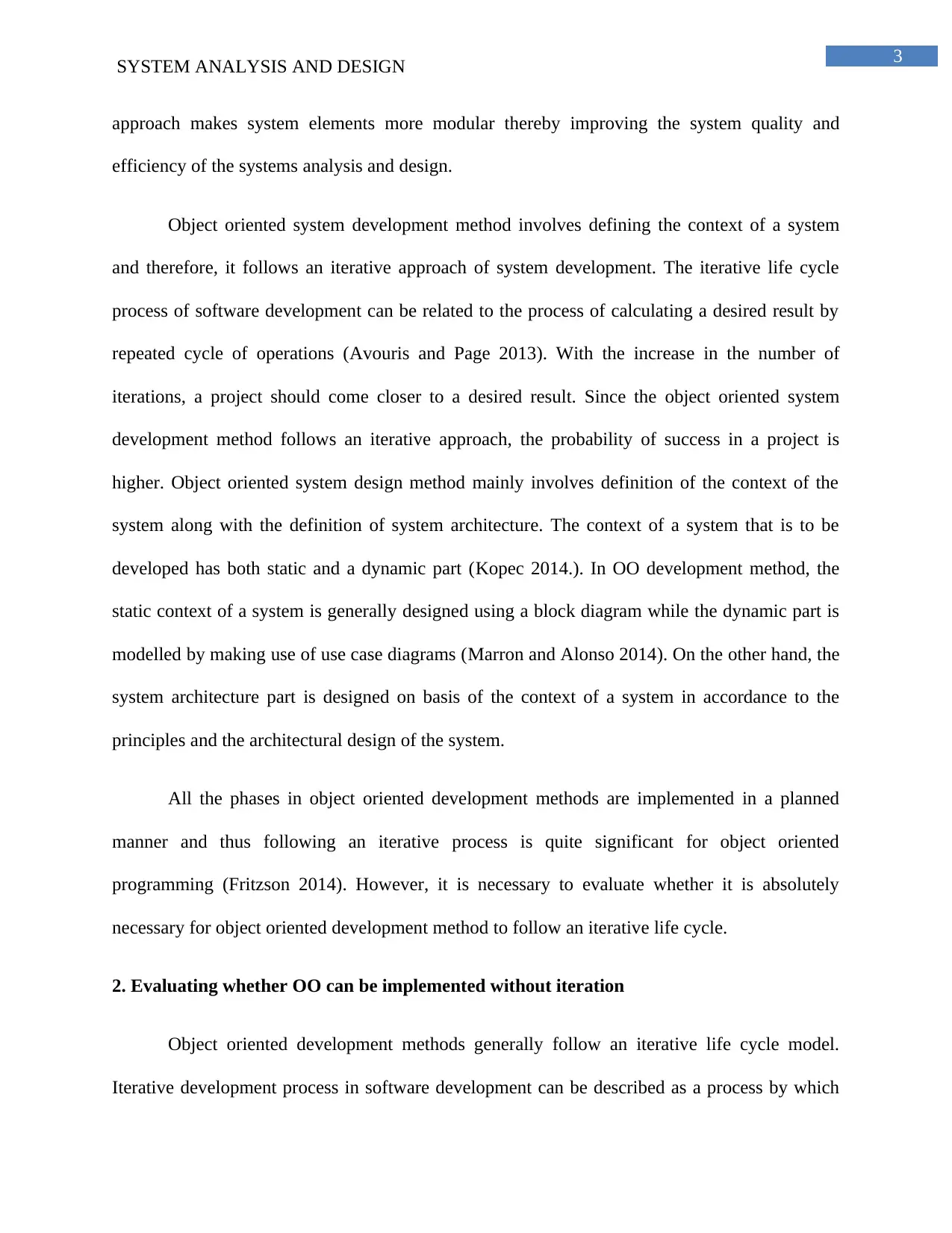
3
SYSTEM ANALYSIS AND DESIGN
approach makes system elements more modular thereby improving the system quality and
efficiency of the systems analysis and design.
Object oriented system development method involves defining the context of a system
and therefore, it follows an iterative approach of system development. The iterative life cycle
process of software development can be related to the process of calculating a desired result by
repeated cycle of operations (Avouris and Page 2013). With the increase in the number of
iterations, a project should come closer to a desired result. Since the object oriented system
development method follows an iterative approach, the probability of success in a project is
higher. Object oriented system design method mainly involves definition of the context of the
system along with the definition of system architecture. The context of a system that is to be
developed has both static and a dynamic part (Kopec 2014.). In OO development method, the
static context of a system is generally designed using a block diagram while the dynamic part is
modelled by making use of use case diagrams (Marron and Alonso 2014). On the other hand, the
system architecture part is designed on basis of the context of a system in accordance to the
principles and the architectural design of the system.
All the phases in object oriented development methods are implemented in a planned
manner and thus following an iterative process is quite significant for object oriented
programming (Fritzson 2014). However, it is necessary to evaluate whether it is absolutely
necessary for object oriented development method to follow an iterative life cycle.
2. Evaluating whether OO can be implemented without iteration
Object oriented development methods generally follow an iterative life cycle model.
Iterative development process in software development can be described as a process by which
SYSTEM ANALYSIS AND DESIGN
approach makes system elements more modular thereby improving the system quality and
efficiency of the systems analysis and design.
Object oriented system development method involves defining the context of a system
and therefore, it follows an iterative approach of system development. The iterative life cycle
process of software development can be related to the process of calculating a desired result by
repeated cycle of operations (Avouris and Page 2013). With the increase in the number of
iterations, a project should come closer to a desired result. Since the object oriented system
development method follows an iterative approach, the probability of success in a project is
higher. Object oriented system design method mainly involves definition of the context of the
system along with the definition of system architecture. The context of a system that is to be
developed has both static and a dynamic part (Kopec 2014.). In OO development method, the
static context of a system is generally designed using a block diagram while the dynamic part is
modelled by making use of use case diagrams (Marron and Alonso 2014). On the other hand, the
system architecture part is designed on basis of the context of a system in accordance to the
principles and the architectural design of the system.
All the phases in object oriented development methods are implemented in a planned
manner and thus following an iterative process is quite significant for object oriented
programming (Fritzson 2014). However, it is necessary to evaluate whether it is absolutely
necessary for object oriented development method to follow an iterative life cycle.
2. Evaluating whether OO can be implemented without iteration
Object oriented development methods generally follow an iterative life cycle model.
Iterative development process in software development can be described as a process by which
Paraphrase This Document
Need a fresh take? Get an instant paraphrase of this document with our AI Paraphraser
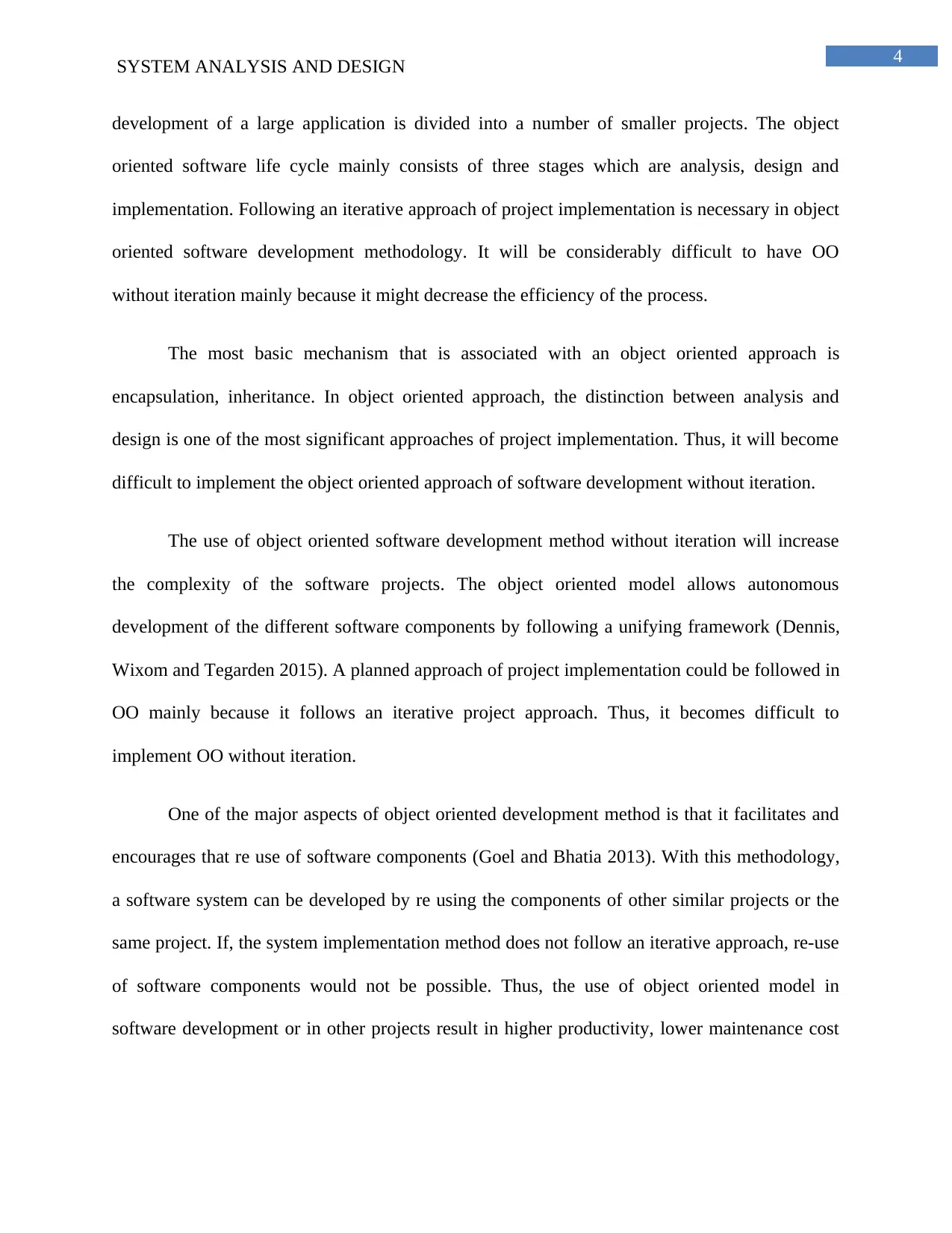
4
SYSTEM ANALYSIS AND DESIGN
development of a large application is divided into a number of smaller projects. The object
oriented software life cycle mainly consists of three stages which are analysis, design and
implementation. Following an iterative approach of project implementation is necessary in object
oriented software development methodology. It will be considerably difficult to have OO
without iteration mainly because it might decrease the efficiency of the process.
The most basic mechanism that is associated with an object oriented approach is
encapsulation, inheritance. In object oriented approach, the distinction between analysis and
design is one of the most significant approaches of project implementation. Thus, it will become
difficult to implement the object oriented approach of software development without iteration.
The use of object oriented software development method without iteration will increase
the complexity of the software projects. The object oriented model allows autonomous
development of the different software components by following a unifying framework (Dennis,
Wixom and Tegarden 2015). A planned approach of project implementation could be followed in
OO mainly because it follows an iterative project approach. Thus, it becomes difficult to
implement OO without iteration.
One of the major aspects of object oriented development method is that it facilitates and
encourages that re use of software components (Goel and Bhatia 2013). With this methodology,
a software system can be developed by re using the components of other similar projects or the
same project. If, the system implementation method does not follow an iterative approach, re-use
of software components would not be possible. Thus, the use of object oriented model in
software development or in other projects result in higher productivity, lower maintenance cost
SYSTEM ANALYSIS AND DESIGN
development of a large application is divided into a number of smaller projects. The object
oriented software life cycle mainly consists of three stages which are analysis, design and
implementation. Following an iterative approach of project implementation is necessary in object
oriented software development methodology. It will be considerably difficult to have OO
without iteration mainly because it might decrease the efficiency of the process.
The most basic mechanism that is associated with an object oriented approach is
encapsulation, inheritance. In object oriented approach, the distinction between analysis and
design is one of the most significant approaches of project implementation. Thus, it will become
difficult to implement the object oriented approach of software development without iteration.
The use of object oriented software development method without iteration will increase
the complexity of the software projects. The object oriented model allows autonomous
development of the different software components by following a unifying framework (Dennis,
Wixom and Tegarden 2015). A planned approach of project implementation could be followed in
OO mainly because it follows an iterative project approach. Thus, it becomes difficult to
implement OO without iteration.
One of the major aspects of object oriented development method is that it facilitates and
encourages that re use of software components (Goel and Bhatia 2013). With this methodology,
a software system can be developed by re using the components of other similar projects or the
same project. If, the system implementation method does not follow an iterative approach, re-use
of software components would not be possible. Thus, the use of object oriented model in
software development or in other projects result in higher productivity, lower maintenance cost
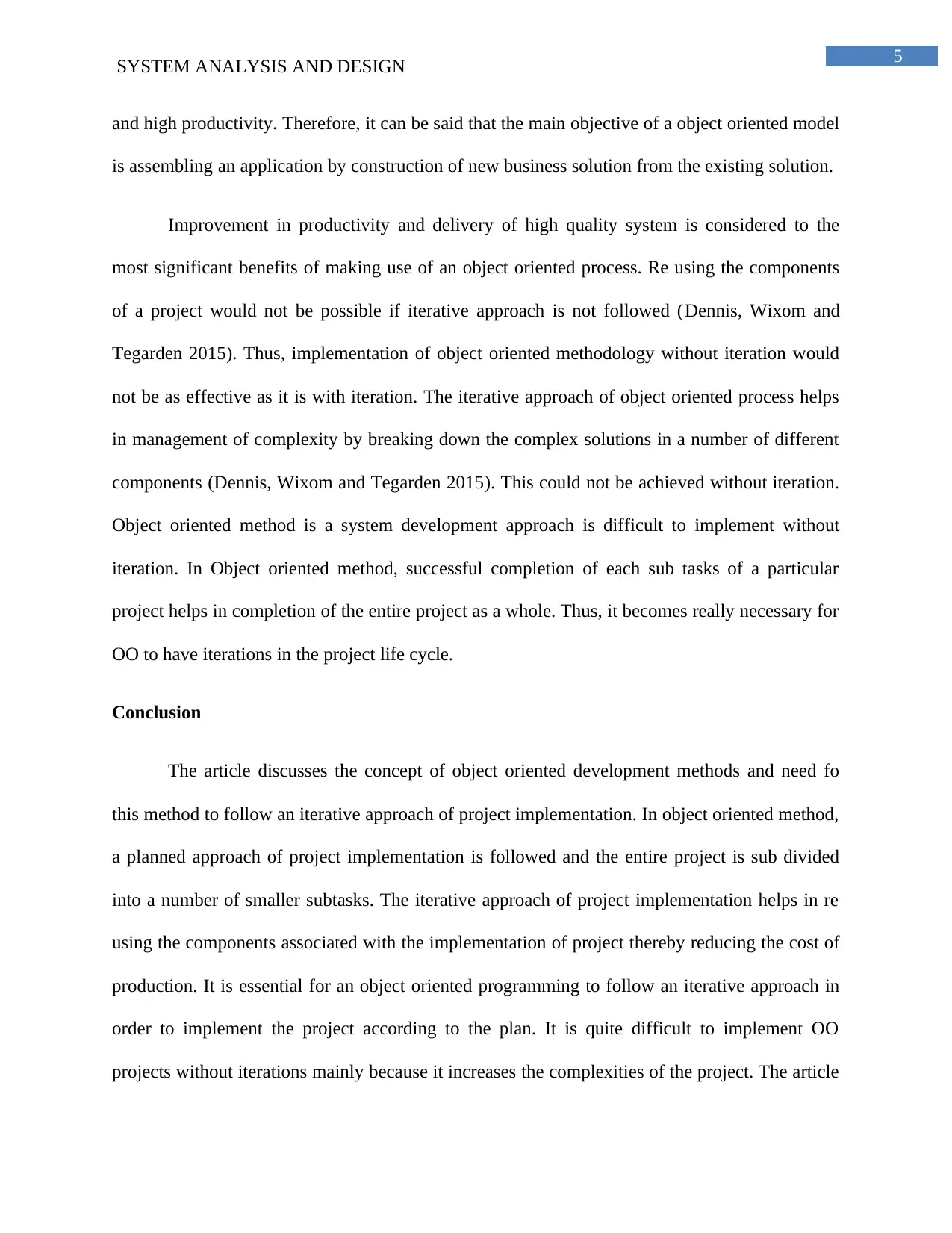
5
SYSTEM ANALYSIS AND DESIGN
and high productivity. Therefore, it can be said that the main objective of a object oriented model
is assembling an application by construction of new business solution from the existing solution.
Improvement in productivity and delivery of high quality system is considered to the
most significant benefits of making use of an object oriented process. Re using the components
of a project would not be possible if iterative approach is not followed (Dennis, Wixom and
Tegarden 2015). Thus, implementation of object oriented methodology without iteration would
not be as effective as it is with iteration. The iterative approach of object oriented process helps
in management of complexity by breaking down the complex solutions in a number of different
components (Dennis, Wixom and Tegarden 2015). This could not be achieved without iteration.
Object oriented method is a system development approach is difficult to implement without
iteration. In Object oriented method, successful completion of each sub tasks of a particular
project helps in completion of the entire project as a whole. Thus, it becomes really necessary for
OO to have iterations in the project life cycle.
Conclusion
The article discusses the concept of object oriented development methods and need fo
this method to follow an iterative approach of project implementation. In object oriented method,
a planned approach of project implementation is followed and the entire project is sub divided
into a number of smaller subtasks. The iterative approach of project implementation helps in re
using the components associated with the implementation of project thereby reducing the cost of
production. It is essential for an object oriented programming to follow an iterative approach in
order to implement the project according to the plan. It is quite difficult to implement OO
projects without iterations mainly because it increases the complexities of the project. The article
SYSTEM ANALYSIS AND DESIGN
and high productivity. Therefore, it can be said that the main objective of a object oriented model
is assembling an application by construction of new business solution from the existing solution.
Improvement in productivity and delivery of high quality system is considered to the
most significant benefits of making use of an object oriented process. Re using the components
of a project would not be possible if iterative approach is not followed (Dennis, Wixom and
Tegarden 2015). Thus, implementation of object oriented methodology without iteration would
not be as effective as it is with iteration. The iterative approach of object oriented process helps
in management of complexity by breaking down the complex solutions in a number of different
components (Dennis, Wixom and Tegarden 2015). This could not be achieved without iteration.
Object oriented method is a system development approach is difficult to implement without
iteration. In Object oriented method, successful completion of each sub tasks of a particular
project helps in completion of the entire project as a whole. Thus, it becomes really necessary for
OO to have iterations in the project life cycle.
Conclusion
The article discusses the concept of object oriented development methods and need fo
this method to follow an iterative approach of project implementation. In object oriented method,
a planned approach of project implementation is followed and the entire project is sub divided
into a number of smaller subtasks. The iterative approach of project implementation helps in re
using the components associated with the implementation of project thereby reducing the cost of
production. It is essential for an object oriented programming to follow an iterative approach in
order to implement the project according to the plan. It is quite difficult to implement OO
projects without iterations mainly because it increases the complexities of the project. The article
⊘ This is a preview!⊘
Do you want full access?
Subscribe today to unlock all pages.

Trusted by 1+ million students worldwide
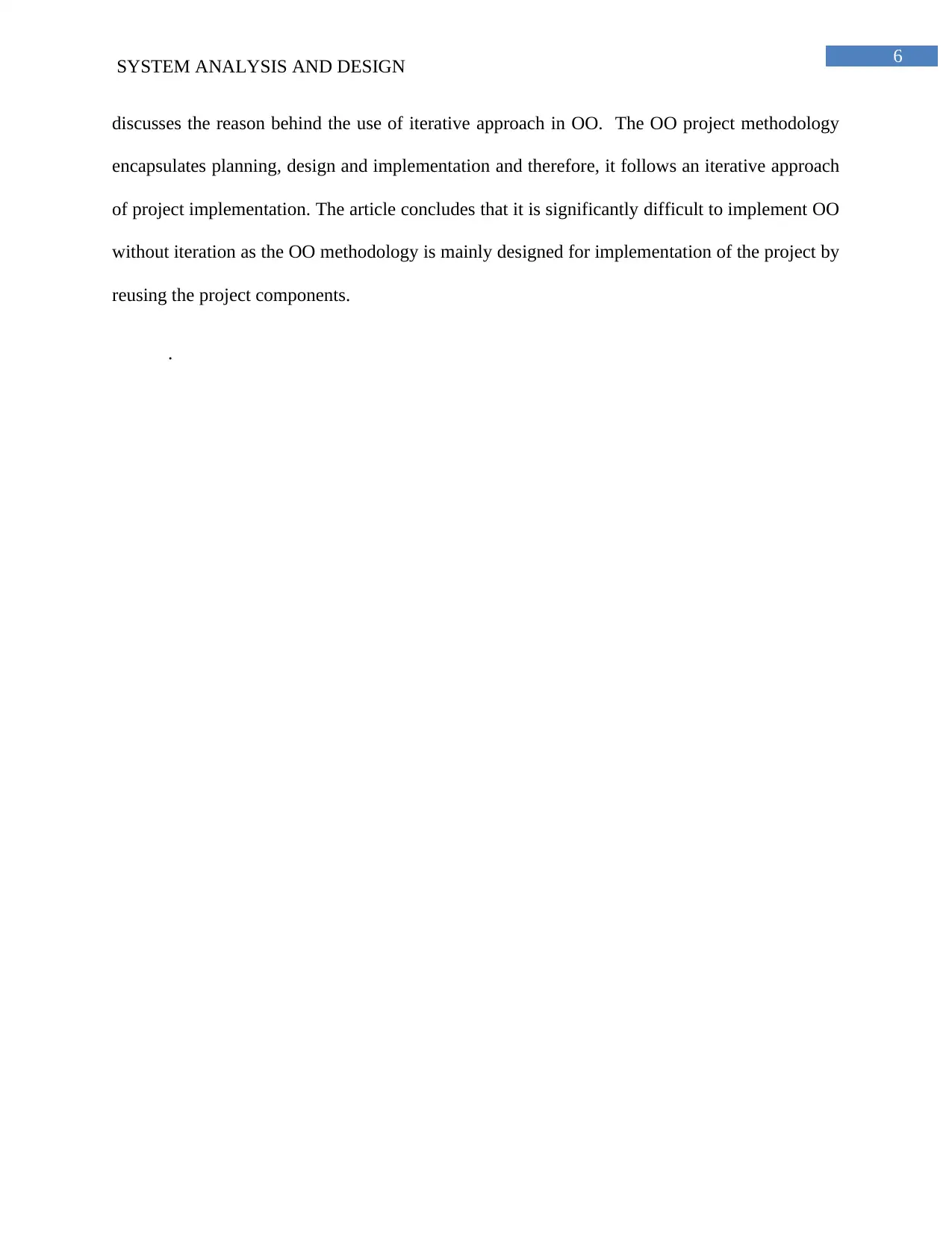
6
SYSTEM ANALYSIS AND DESIGN
discusses the reason behind the use of iterative approach in OO. The OO project methodology
encapsulates planning, design and implementation and therefore, it follows an iterative approach
of project implementation. The article concludes that it is significantly difficult to implement OO
without iteration as the OO methodology is mainly designed for implementation of the project by
reusing the project components.
.
SYSTEM ANALYSIS AND DESIGN
discusses the reason behind the use of iterative approach in OO. The OO project methodology
encapsulates planning, design and implementation and therefore, it follows an iterative approach
of project implementation. The article concludes that it is significantly difficult to implement OO
without iteration as the OO methodology is mainly designed for implementation of the project by
reusing the project components.
.
Paraphrase This Document
Need a fresh take? Get an instant paraphrase of this document with our AI Paraphraser
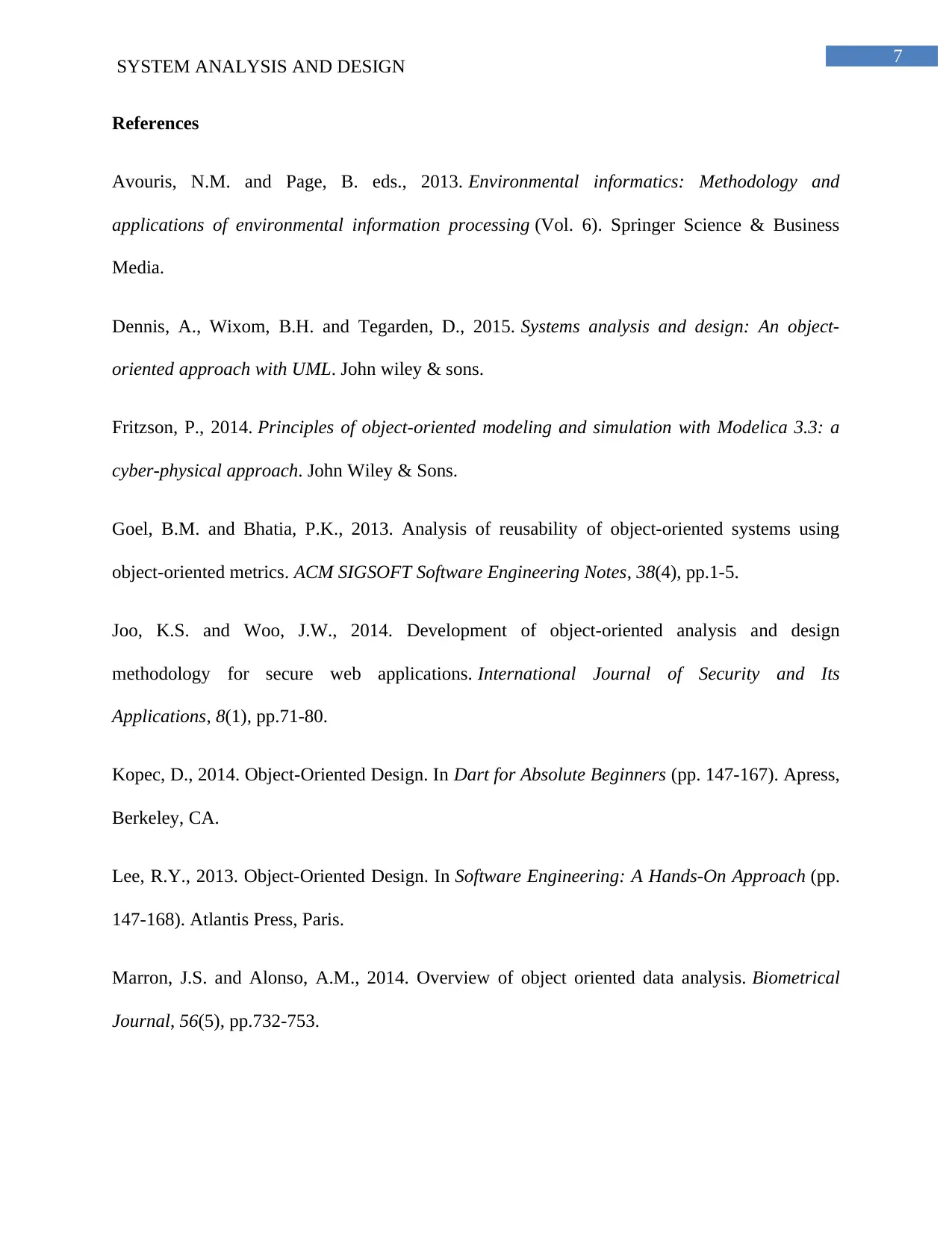
7
SYSTEM ANALYSIS AND DESIGN
References
Avouris, N.M. and Page, B. eds., 2013. Environmental informatics: Methodology and
applications of environmental information processing (Vol. 6). Springer Science & Business
Media.
Dennis, A., Wixom, B.H. and Tegarden, D., 2015. Systems analysis and design: An object-
oriented approach with UML. John wiley & sons.
Fritzson, P., 2014. Principles of object-oriented modeling and simulation with Modelica 3.3: a
cyber-physical approach. John Wiley & Sons.
Goel, B.M. and Bhatia, P.K., 2013. Analysis of reusability of object-oriented systems using
object-oriented metrics. ACM SIGSOFT Software Engineering Notes, 38(4), pp.1-5.
Joo, K.S. and Woo, J.W., 2014. Development of object-oriented analysis and design
methodology for secure web applications. International Journal of Security and Its
Applications, 8(1), pp.71-80.
Kopec, D., 2014. Object-Oriented Design. In Dart for Absolute Beginners (pp. 147-167). Apress,
Berkeley, CA.
Lee, R.Y., 2013. Object-Oriented Design. In Software Engineering: A Hands-On Approach (pp.
147-168). Atlantis Press, Paris.
Marron, J.S. and Alonso, A.M., 2014. Overview of object oriented data analysis. Biometrical
Journal, 56(5), pp.732-753.
SYSTEM ANALYSIS AND DESIGN
References
Avouris, N.M. and Page, B. eds., 2013. Environmental informatics: Methodology and
applications of environmental information processing (Vol. 6). Springer Science & Business
Media.
Dennis, A., Wixom, B.H. and Tegarden, D., 2015. Systems analysis and design: An object-
oriented approach with UML. John wiley & sons.
Fritzson, P., 2014. Principles of object-oriented modeling and simulation with Modelica 3.3: a
cyber-physical approach. John Wiley & Sons.
Goel, B.M. and Bhatia, P.K., 2013. Analysis of reusability of object-oriented systems using
object-oriented metrics. ACM SIGSOFT Software Engineering Notes, 38(4), pp.1-5.
Joo, K.S. and Woo, J.W., 2014. Development of object-oriented analysis and design
methodology for secure web applications. International Journal of Security and Its
Applications, 8(1), pp.71-80.
Kopec, D., 2014. Object-Oriented Design. In Dart for Absolute Beginners (pp. 147-167). Apress,
Berkeley, CA.
Lee, R.Y., 2013. Object-Oriented Design. In Software Engineering: A Hands-On Approach (pp.
147-168). Atlantis Press, Paris.
Marron, J.S. and Alonso, A.M., 2014. Overview of object oriented data analysis. Biometrical
Journal, 56(5), pp.732-753.
1 out of 8
Related Documents
Your All-in-One AI-Powered Toolkit for Academic Success.
+13062052269
info@desklib.com
Available 24*7 on WhatsApp / Email
![[object Object]](/_next/static/media/star-bottom.7253800d.svg)
Unlock your academic potential
Copyright © 2020–2025 A2Z Services. All Rights Reserved. Developed and managed by ZUCOL.



